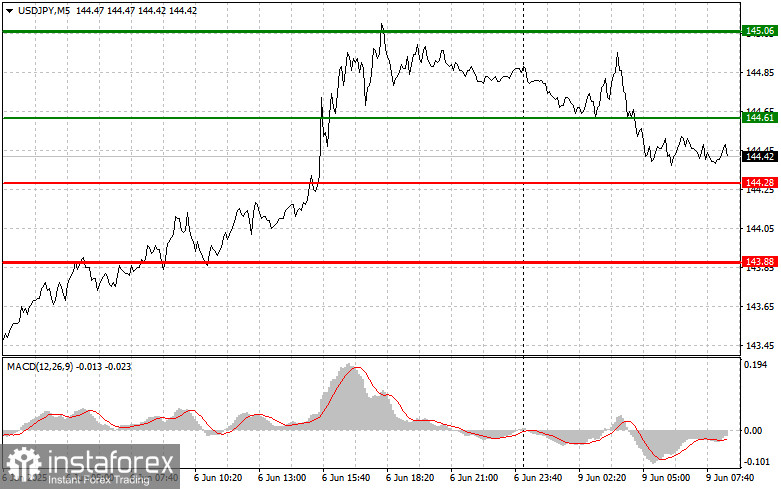Analysis of Trades and Trading Tips for the Japanese Yen
The price test at 144.27 occurred when the MACD indicator had already moved significantly above the zero line, but the strong U.S. labor market data offered a high probability of the dollar strengthening against the yen, which I decided to take advantage of. As a result, the pair rose toward the target level of 145.06.
The confident growth in U.S. non-farm employment recorded in May exceeded experts' expectations, causing noticeable fluctuations in currency markets. The publication of data showing the creation of 139,000 new jobs versus the forecasted 127,000 instantly strengthened the U.S. dollar, putting pressure on the Japanese yen. The yen's reaction to the news was immediate: the currency weakened significantly against the dollar. Investors perceived the data as a signal of the strength of the U.S. economy and the likely continuation of the Federal Reserve's tight monetary policy. Furthermore, the stable unemployment rate in the U.S., recorded at 4.2%, also reinforced the market's optimistic sentiment.
Today's data shows that Japan's GDP for the first quarter was revised upward, which helped the yen recover slightly from Friday's losses against the U.S. dollar. However, despite the positive revisions, Japan's economy still faces serious challenges. Weak domestic demand and an aging population continue to pressure growth, while geopolitical uncertainty poses additional obstacles. The Bank of Japan maintains a wait-and-see approach and has no plans to raise interest rates for now, which had previously provided good support to the yen. Strong growth in bank lending also contributed to increased demand for the yen.
For intraday strategy, I will focus primarily on implementing Scenarios #1 and #2.

Buy Scenario
Scenario #1: Today, I plan to buy USD/JPY if the entry point around 144.61 (green line) is reached, with a target to rise to 145.06 (thicker green line on the chart). Around 145.06, I plan to exit long positions and immediately open short positions (targeting a 30-35 pip move in the opposite direction). It's best to return to buying the pair during corrections and significant pullbacks in USD/JPY. Important! Before buying, ensure the MACD indicator is above the zero line and just beginning its upward movement from it.
Scenario #2: I also plan to buy USD/JPY today in case of two consecutive tests of the 144.28 level when the MACD indicator is in the oversold area. This will limit the downside potential of the pair and lead to an upward market reversal. Growth can be expected toward the opposite levels of 144.61 and 145.06.
Sell Scenario
Scenario #1: I plan to sell USD/JPY today only after breaking below 144.28 (red line on the chart), which will lead to a quick decline in the pair. The key target for sellers will be the 143.88 level, where I plan to exit short positions and immediately open long positions (targeting a 20-25 pip move in the opposite direction). Selling pressure on the pair may return quickly today. Important! Before selling, make sure the MACD indicator is below the zero line and just beginning its downward movement from it.
Scenario #2: I also plan to sell USD/JPY today in case of two consecutive tests of the 144.61 level when the MACD indicator is in the overbought area. This will limit the upside potential of the pair and lead to a downward market reversal. A decline can be expected toward the opposite levels of 144.28 and 143.88.

What's on the Chart:
- The thin green line represents the entry price where the trading instrument can be bought.
- The thick green line indicates the expected price level where a Take Profit order can be placed, or profits can be manually secured, as further price growth above this level is unlikely.
- The thin red line represents the entry price where the trading instrument can be sold.
- The thick red line indicates the expected price level where a Take Profit order can be placed, or profits can be manually secured, as further price decline below this level is unlikely.
- The MACD indicator should be used to assess overbought and oversold zones when entering the market.
Important Notes:
- Beginner Forex traders should exercise extreme caution when making market entry decisions. It is advisable to stay out of the market before the release of important fundamental reports to avoid exposure to sharp price fluctuations. If you choose to trade during news releases, always use stop-loss orders to minimize potential losses. Trading without stop-loss orders can quickly wipe out your entire deposit, especially if you neglect money management principles and trade with high volumes.
- Remember, successful trading requires a well-defined trading plan, similar to the one outlined above. Making impulsive trading decisions based on the current market situation is a losing strategy for intraday traders.
 English
English 
 Русский
Русский Bahasa Indonesia
Bahasa Indonesia Bahasa Malay
Bahasa Malay ไทย
ไทย Español
Español Deutsch
Deutsch Български
Български Français
Français Tiếng Việt
Tiếng Việt 中文
中文 বাংলা
বাংলা हिन्दी
हिन्दी Čeština
Čeština Українська
Українська Română
Română

